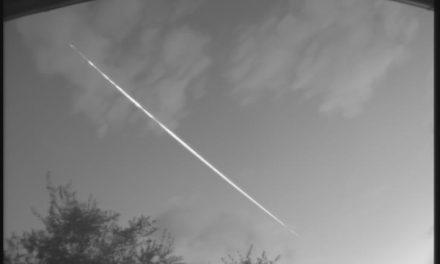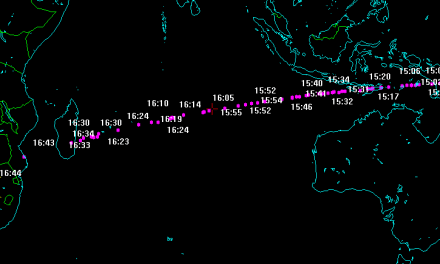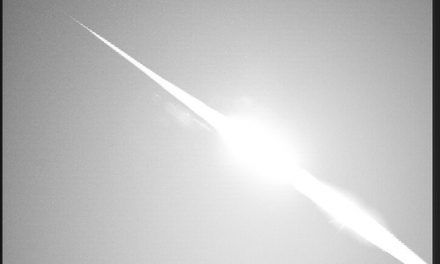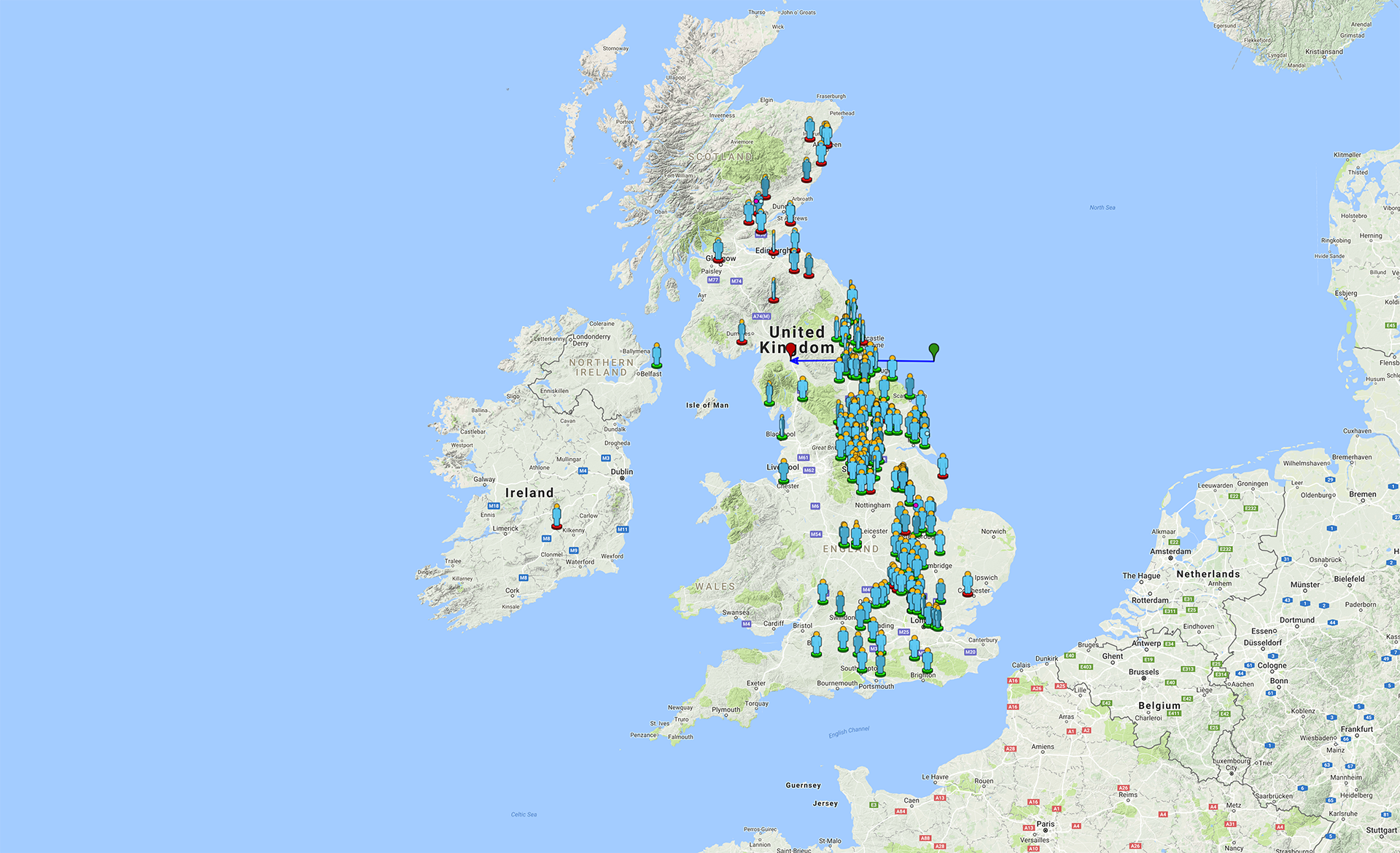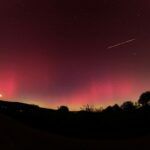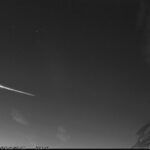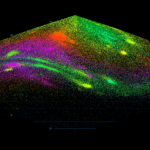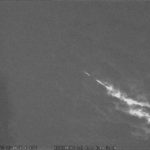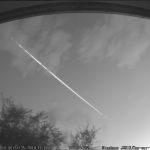Against the background of raging disturbances in the Earth’s magnetosphere caused by the solar wind, which were the strongest since November 2003, a very slow bolide was recorded by the cameras of the CEMeNt network on 10/05/2024 in the late evening hours (22h43m23s CEST). The bolide was recorded by two cameras at the Valašské Meziříčí Observatory, cameras at the Vsetín, Ždánice and Kysucké Nové Mesto Observatories and at a private station in Jablonec near Trnava. The spectrum of this relatively bright and slow meteor was also recorded. In combination with the ongoing geomagnetic storm, observers had a very interesting view of the combination of both phenomena taking place in the Earth’s atmosphere.
The aurora borealis on the night of 10/5-11/5/2024 made history by being captured from Puerto Rico and Mexico, making it the most southerly recorded aurora in the Northern Hemisphere in observational history. From the southern hemisphere it was then observed, for example, from the Republic of South Africa. The reason for the appearance of this massive phenomenon was the stormy activity of the Sun, which produced 10 strong eruptions the day before the phenomenon, especially from the active sunspot region AR 3664. The combination of both phenomena is then visible in the opening photo taken by Marek Macko. The aurora was recorded by the CEMeNt network wide-field cameras on many images, a selection of the most interesting ones for the stations Valašské Meziříčí (CZ), Partizánske (SK) and Jablonec (SK) is given at the end of the article (Fig. 11-25).
The 20240510_204323 bolide was recorded by the cameras of the CEMeNt network on 10/05/2024 at 20h43m23.9 ± 0.1s UT. As part of the CEMeNt (Central European MetEor NeTwork), the bolide was recorded directly on six wide-field cameras (Fig. 1-6). The flight record of the bolide is available from the stations Valašské Meziříčí SE and NE (CZ, Valašské Meziříčí Observatory), Ždánice E (CZ, Ždánice Observatory), Vsetín E (CZ, Vsetín Observatory), Kysucké Nové Mesto (SK, Kysucké Nové Mesto Observatory) and Jablonec near Trnava (SK, Jakub Kapuš). In addition to these stations, the spectrum of the bolide’s flight was recorded by spectrographs at the Valašské Meziříčí Observatory (spectrograph VM_SPSE and VM_SPNE). Unfortunately, the spectrum is very weak and the signal/noise ratio is not sufficient for its evaluation, however a look at the spectrum shows that in the case of this bolide it was a body rich in sodium (Na-enhanced or Na-rich).
ATMOSPHERIC TRAJECTORY, RADIANT AND HELIOCENTRIC ORBIT
To calculate the atmospheric trajectory of the bolide and the orbit of the meteoroid in the Solar System, recordings taken from the stations Valašské Meziříčí NE and SE, Kysucké Nové Mesto, Vsetín E, Jablonec N were used. The recording from these stations was made by the UFO Capture software, the recording was processed by the UFO Analyzer and calculation of the atmospheric and heliocentric orbit in the UFO Orbit (Sonotaco, 2009). The projection of the beginning of the atmospheric trajectory was located at the coordinates N49.622467° E18.939476° near the village of Cienków (PL) east of Wisla (PL), the height of the meteor at that moment was 78.9 km above the Earth’s surface. The projection of the end of the atmospheric trajectory was located at the coordinates N49.22398° E19.080387° near the village of Štefanová (SK) east of Žilina (SK), the height of the meteor at this moment was 35.3 km above the Earth’s surface (Fig. 7). In this case, these are geographical coordinates and heights from the calculation of the bolide trajectory, where images of the bolide from the beginning and end of the ablation path are removed. Including all images of the ablation path of the bolide, the initial height of the observed atmospheric path of the bolide is 81.1 km and the final height is 32.6 km. The bolide reached an absolute brightness of -3.2m and traveled a distance of 63.4 km in the Earth’s atmosphere during 6.2 s of flight.
The body entered the Earth’s atmosphere at an ideal angle of 44.2°, the speed before entering the atmosphere was 12.51 km/s. It was therefore a very slow bolide, the geocentric velocity of the meteoroid was 5.73 km/s (Tab. 1). The body did not belong to any known meteor shower, so it was a sporadic meteor. Before entering the atmosphere, the body moved along a slightly eccentric path (Fig. 8) with low eccentricity e= 0.179, low inclination to the ecliptic plane i= 7.28° and perihelion q= 0.9336. The body was of asteroid origin with an unknown parent body, based on the orbital similarity criterion, the closest known asteroid is 2014 HG197 (DD= 0.097).
PHYSICAL PROPERTIES OF THE METEOROID
In the case of the bolide 20240510_204323, the initial weight of the body and its other physical properties can be estimated based on the heliocentric trajectory elements and the atmospheric trajectory. For the initial determination of the parameters of the heliocentric trajectory of the meteoroid, the Tisserand parameter of the orbit in relation to Jupiter was calculated. Depending on the value of the Tisserand parameter, the inclination of the orbit and the aphelion distance, the bodies can be divided into 4 groups. Bolide 20240510_204323 has the value of the Tisserand parameter TJ = 5.489, according to this classification, the bolide belongs to the AST group, i.e. to the group of meteoroids with an asteroid origin. However, according to the KB parameter (7.542), which is a function of material properties and surface temperature (Ceplecha, 1968; Ceplecha and McCrosky, 1976; Ceplecha 1988), it belongs to the group of carbonaceous chondrites. According to the PE parameter (-4.126), the bolide belongs to the group of ordinary chondrites. Using the parameters that characterize the shape, speed and other properties of the body (Tab. 1), it was possible to calculate the initial and final weight of the body.
In parallel with the calculation of the dynamic input mass md, the calculation of the photometric input mass mf was performed. Thus, the initial dynamic mass of the meteoroid before entering the Earth’s atmosphere was 0.77 kg (md). The calculation of the fragmentation strength of a meteoroid is based on the equality of the dynamic pressure and the strength of the body as a whole at the moment of the meteoroid’s disintegration. The atmospheric model parameters at a given decay height are calculated according to the NRLMSISE-00 model (Picone et al., 2002). The moment of disintegration (fragmentation) of the body was determined from the course of the absolute brightness values of the bolide from the Valašské Meziříčí SE station (Fig. 10) and also from the analysis of the recording from the Vsetín E station. During the ablation path of the body, several separations of parts of the body occurred (Fig. 9). The fragmentation strength (Popova et al., 2011) of the main part of the body is 0.120 MPa (fragment A), 0.164 MPa (fragment B) and 0.200 MPa (fragment C), which places the body rather in the group of ordinary chondrites (OC). The determined mineralogical density (Benyukh, 1974) of the body (3.28 g/cm3) also indicates that in the case of bolide 20240510_204323 it was a body belonging to ordinary chondrites with an origin in the group of Apollo-type asteroids.
 |
 |
 |
 |
 |
 |
| Fig. 11-16: Pictures of the aurora borealis on the night of 10/11. 5. 2024 taken by the wide-field camera of Valašské Meziříčí NE. Author: Valašské Meziříčí Observatory, p.o. | ||
 |
 |
 |
 |
 |
 |
| Fig. 17-22: Pictures of the aurora borealis on the night of 10/11. 5. 2024 taken by the wide-field camera of Jablonec N. Author: Author: Jakub Kapuš. | ||
 |
 |
 |
| Fig. 23-25: Pictures of the aurora borealis on the night of 10/11. 5. 2024 taken by the wide-field camera of Partizánske NW. Author: Partizánske Observatory. | ||
ACKNOWLEDGMENT
Thanks go to all operators and owners of stations in the CEMeNt network. Thanks also go to all involved institutions for supporting the activities and growth of the network. The RPOS project (Cross-Border Observational Network Development) was co-financed from the Small Projects Fund of the Interreg V-A Program Slovakia – Czech Republic 2014 – 2020, call code 5/FMP/11b, reg. no. CZ/FMP/11b/05/058. The KOSOAP (Cooperating Network in the Field of Astronomical Observation Programs) and RPKS (Development of Cross-Border Cooperating Network for Professional Work and Education) projects were implemented by the Valašské Meziříčí Observatory (Czech Republic) and the Kysucké Nové Mesto Observatory (Slovakia) in cooperation with SMPH (Society for Interplanetary Matter). The projects were co-financed from the Micro-Projects Fund of the Operational Program for Cross-Border Cooperation Slovakia – Czech Republic 2007-2013. The purchase and operation of high-resolution spectroscopic cameras are partially funded by the Program for Regional Cooperation of the Czech Academy of Sciences, reg. no. R200402101 and grant APVV-0517-12 (FMFI UK). The purchase of instrument equipment located at the Valašské Meziříčí Observatory, p.o., was also supported by DEZA, a.s. and CS CABOT, spol. s r.o.
REFERENCES
Benyukh V. V. (1974). Mineralogical Density of Meteoroids in Several Streams. Solar System Research, 8, p. 82.
Ceplecha Z. (1968). Discrete levels of meteor beginning height (No. NASA-CR-96295).
Ceplecha Z. and McCrosky R. E. (1976). Fireball end heights: A diagnostic for the structure of meteoric material. Journal of Geophysical Research, 81(35), p. 6257-6275.
Ceplecha Z. (1988). Earth’s influx of different populations of sporadic meteoroids from photographic and television data. Astronomical Institutes of Czechoslovakia, Bulletin (ISSN 0004-6248), July 1988, 39, p. 221-236.
Picone J. M., Hedin A. E., Drob D. P. and Aikin A. C. (2002). NRLMSISE‐00 empirical model of the atmosphere: Statistical comparisons and scientific issues. Journal of Geophysical Research: Space Physics, 107(A12), SIA-15.
Popova O., Borovička J., Hartmann W. K., Spurný P., Gnos E., Nemtchinov I. and Trigo‐Rodríguez J. M. (2011). Very low strengths of interplanetary meteoroids and small asteroids. Meteoritics & Planetary Science, 46(10), p. 1525-1550.
SonotaCo (2009). A meteor shower catalog based on video observations in 2007-2008. WGN, Journal of the International Meteor Organization 37:2, 2009, p. 55-62.













